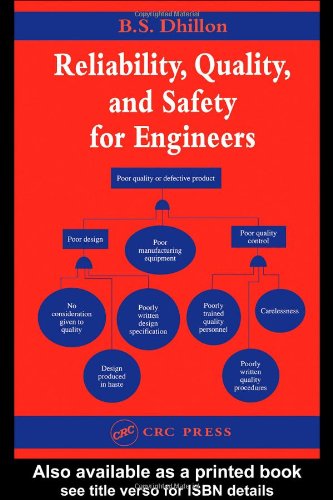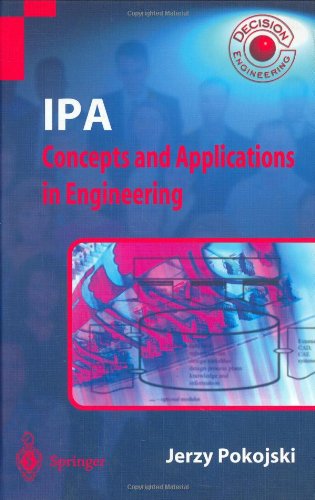B.S. Dhillon9780849330681, 0-8493-3068-8
Table of contents :
Reliability, Quality, and Safety for Engineers……Page 1
Dedication……Page 3
Preface……Page 4
Author Biography……Page 6
Contents……Page 7
1.1 Need for Reliability, Quality, and Safety……Page 14
Contents……Page 0
1.2.2 Quality……Page 15
1.3 Terms and Definitions……Page 16
1.4.1 Journals……Page 18
1.4.2 Standards……Page 19
1.4.3 Conference Proceedings……Page 20
1.4.5 Books……Page 21
1.5 Problems……Page 22
References……Page 23
2.2 Mode, Median, Range, Arithmetic Mean, Root Mean Square, Mean Deviation, and Standard Deviation……Page 25
2.2.2 Median……Page 26
2.2.4 Arithmetic Mean……Page 27
2.2.6 Mean Deviation……Page 28
2.2.7 Standard Deviation……Page 29
2.4 Probability Definition and Properties……Page 30
2.5.1 Probability Density and Cumulative Distribution Functions……Page 32
2.5.3 Variance……Page 33
2.5.5 Laplace Transform: Final- Value Theorem……Page 34
2.6 Solving First Order Differential Equations with Laplace Transforms……Page 35
2.7.2 Binomial Distribution……Page 37
2.7.3 Poisson Distribution……Page 38
2.7.5 Rayleigh Distribution……Page 39
2.8 Problems……Page 40
References……Page 41
3.1 Need for Reliability……Page 42
3.2 Bathtub Hazard Rate Curve……Page 43
3.3.1 Hazard Rate for Exponential Distribution……Page 44
3.3.3 Hazard Rate for General Distribution……Page 45
3.4 General and Specific Reliability Functions……Page 46
3.5 Mean Time to Failure……Page 47
3.5.1 Equation ( 3.19) Derivation……Page 48
3.5.2 Equation ( 3.20) Derivation……Page 49
3.6 Failure Rate Estimation……Page 51
3.7 Failure Data Collection, Sources, and Failure Rates for Selected Items……Page 53
3.8 Problems……Page 54
References……Page 56
4.2 Series Network……Page 57
4.3 Parallel Network……Page 59
4.4 k-Out-of-m Network……Page 61
4.5 Series- Parallel Network……Page 62
4.6 Parallel- Series Network……Page 64
4.7 Bridge Network……Page 66
4.8 Problems……Page 68
References……Page 69
5.2 Series Network……Page 70
5.2.1 Series System Reliability and Mean Time to Failure……Page 72
5.2.2 Series System Reliability with Nonconstant Failure Rates of Units……Page 73
5.3 Parallel Network……Page 74
5.4 k-Out-of-m Network……Page 76
5.5 Series- Parallel Network……Page 79
5.6 Parallel- Series Network……Page 80
5.7 Standby System……Page 81
5.8 Bridge Network……Page 83
5.9 Problems……Page 84
References……Page 85
6.2 Network Reduction Method……Page 87
6.3.1 Fault Tree Symbols and Basic Steps for Developing a Fault Tree……Page 90
6.3.2 Probability Evaluation of Fault Trees……Page 91
6.4 Markov Method……Page 94
6.5 Decomposition Method……Page 95
6.6 Failure Modes and Effect Analysis ( FMEA) Method……Page 98
6.7 Common Cause Failure Analysis Method……Page 99
6.8 Problems……Page 103
References……Page 104
7.2 Types of Reliability Testing……Page 106
7.3.1 Test I……Page 108
7.3.2 Test II……Page 110
7.4 Confidence Limit Estimation on Mean Item Life……Page 112
7.4.1 Method I……Page 113
7.4.2 Method II……Page 114
7.5 Economics of Testing……Page 116
7.6 Problems……Page 117
References……Page 118
8.2 General Management Reliability Program- Related Responsibilities and Guiding Force Associated Facts for an Effective Reliability Program……Page 119
8.3 An Approach for Developing Reliability Goals and Useful Guidelines for Developing Reliability Programs……Page 121
8.4 Reliability Engineering Department Responsibilities and Tasks of a Reliability Engineer……Page 122
8.5 Reliability Cost……Page 123
8.6 Reliability Activity Cost Estimation Models……Page 124
8.6.3 Reliability and Maintainability Program Plan Manhour Estimation Model……Page 125
8.6.6 Failure Reporting and Corrective Action System ( FRACAS) Manhour Estimation Model……Page 126
References……Page 127
9.2 Comparisons of Modern and Traditional Products, Direct Factors Influencing the Quality of Product and Services, and Quality Design Characteristics……Page 129
9.3 Quality Goals……Page 130
9.4 Quality Assurance System Elements……Page 131
9.5 Design for Quality……Page 132
9.6 Total Quality Management ( TQM)……Page 133
9.6.1 TQM Elements and Goals for TQM Process Success……Page 134
9.6.2 Deming Approach to TQM……Page 135
9.6.3 Obstacles to TQM Implementation……Page 136
Organizations……Page 137
References……Page 138
10.2 Quality Control Charts……Page 140
10.2.1 The p-Charts……Page 141
10.2.2 The R-Charts……Page 143
10.2.3 The X Charts……Page 146
10.2.4 The c-Charts……Page 148
10.4 Quality Function Deployment ( QFD)……Page 151
10.5 Scatter Diagram……Page 152
10.6 Cause- and- Effect Diagram……Page 154
10.7 Hoshin Kanri……Page 155
10.9 Fault Tree Analysis ( FTA)……Page 156
10.11 Problems……Page 158
References……Page 159
11.2 Upper and Middle Management Quality- Related Roles……Page 160
11.3 Quality Control Engineering Functions and Quality- Related Responsibilities Among Various Organizational Groups……Page 161
11.4 Steps for Planning the Quality Control Organizational Structure and Quality Control Organizational Methods……Page 162
11.5 Quality Manager Attributes, Functions, and Reasons for Failure……Page 164
11.7 Procurement Quality Control……Page 165
11.7.2 Incoming Material Inspection……Page 166
11.7.3.2 Regular Inspector Waste Estimation Formula……Page 167
11.7.3.3 Vendor Quality Rating Formula……Page 168
11.8.1.2 Costs of External Failures……Page 169
11.9.1 Index I……Page 170
11.10 Problems……Page 171
References……Page 172
12.2 Safety- Related Facts and Figures……Page 173
12.3 Engineers and Safety……Page 174
12.4 Product Hazard Classifications and Common Mechanical Injuries……Page 175
12.5 Statute, Common, Administrative, and Liability Laws and Product Liability……Page 177
12.7 Problems……Page 179
References……Page 180
13.2 Cause and Effect Diagram ( CAED)……Page 181
13.3 Fault Tree Analysis ( FTA)……Page 182
13.4 Control Charts……Page 184
13.5 Markov Method……Page 185
13.8 Technic of Operations Review ( TOR)……Page 188
13.9 Interface Safety Analysis ( ISA)……Page 190
13.11.1 Disabling Injury Severity Rate ( DISR)……Page 191
13.12 Problems……Page 192
References……Page 193
14.2 Safety Management Principles and Developing a Safety Program Plan……Page 194
14.4.1 Safety Manager……Page 196
14.4.2 Safety Engineer……Page 197
14.5 Safety Committees and Motivating Employees to Work Safely……Page 198
14.6 A ManufacturerÌs Losses or Cost due to an Accident Involving its Product……Page 199
14.7.1 The Simonds Method……Page 200
14.7.3 Total Safety Cost Estimation Model……Page 201
14.8.3 Index III……Page 202
References……Page 203
15.1 Introduction……Page 205
15.2.2 Robot Safety Problems……Page 206
15.2.4 Robot Hazard Causes……Page 207
15.2.5 Robot Safeguard Methods……Page 208
15.3.1 Facts and Figures……Page 209
15.3.4 Basic Software System Safety Tasks……Page 210
15.3.5.3 Software Sneak Circuit Analysis……Page 211
15.4.2 Medical Device Safety vs. Reliability……Page 212
15.4.3 Types of Medical Device Safety……Page 213
15.5 Problems……Page 214
References……Page 215







Reviews
There are no reviews yet.